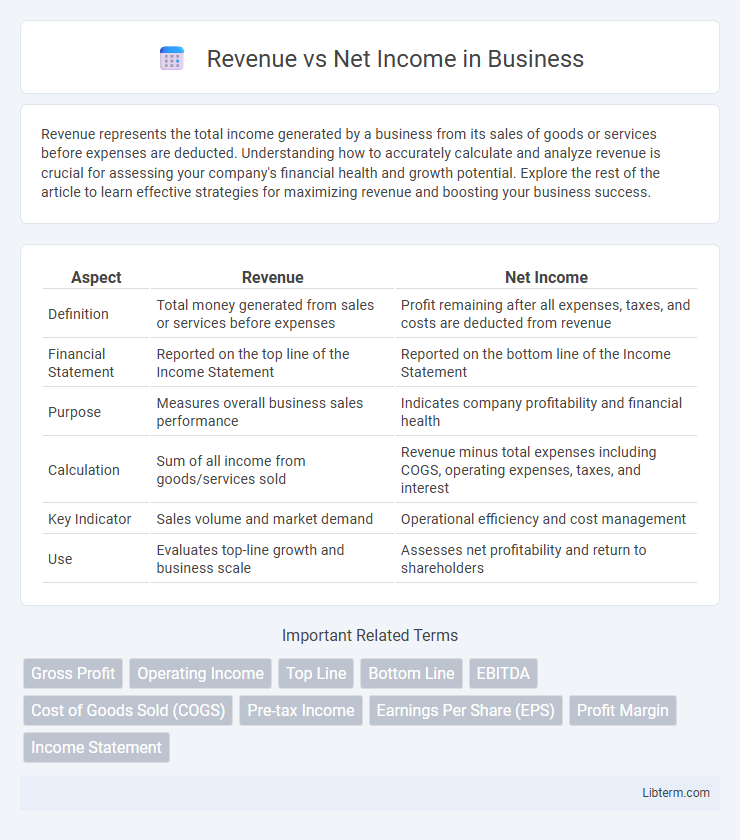Revenue represents the total income generated by a business from its sales of goods or services before expenses are deducted. Understanding how to accurately calculate and analyze revenue is crucial for assessing your company's financial health and growth potential. Explore the rest of the article to learn effective strategies for maximizing revenue and boosting your business success.
Table of Comparison
| Aspect | Revenue | Net Income |
|---|---|---|
| Definition | Total money generated from sales or services before expenses | Profit remaining after all expenses, taxes, and costs are deducted from revenue |
| Financial Statement | Reported on the top line of the Income Statement | Reported on the bottom line of the Income Statement |
| Purpose | Measures overall business sales performance | Indicates company profitability and financial health |
| Calculation | Sum of all income from goods/services sold | Revenue minus total expenses including COGS, operating expenses, taxes, and interest |
| Key Indicator | Sales volume and market demand | Operational efficiency and cost management |
| Use | Evaluates top-line growth and business scale | Assesses net profitability and return to shareholders |
Introduction to Revenue and Net Income
Revenue represents the total amount of money generated from sales or services before any expenses are deducted, serving as a key indicator of a company's top-line performance. Net income, often referred to as the bottom line, reflects the actual profit remaining after all costs, taxes, and expenses have been subtracted from total revenue. Understanding the distinction between revenue and net income is essential for evaluating a business's financial health and operational efficiency.
Defining Revenue: What It Is and How It’s Generated
Revenue represents the total amount of money a company earns from its core business activities, such as sales of goods or services, before any expenses are deducted. It is generated through customer transactions, contracts, and other business operations that directly contribute to the primary income stream. Understanding revenue is crucial as it provides the foundational figure from which profitability metrics like net income are calculated.
Understanding Net Income: The Bottom Line Explained
Net income, often called the bottom line, represents a company's total earnings after deducting all expenses, taxes, and costs from its revenue. It provides a clear measure of profitability by reflecting the actual financial gain, unlike revenue which only indicates total sales or income generated. Understanding net income is crucial for evaluating a company's financial health and operational efficiency beyond just its gross earnings.
Key Differences Between Revenue and Net Income
Revenue represents the total income generated from sales or services before any expenses are deducted, while net income is the profit remaining after all costs, taxes, and expenses are subtracted from revenue. Revenue indicates the company's ability to generate sales, serving as the top-line figure on an income statement, whereas net income reflects the company's profitability, known as the bottom-line measure. Understanding the key differences between revenue and net income is crucial for assessing financial health, operational efficiency, and overall business performance.
Importance of Revenue in Financial Analysis
Revenue serves as a crucial indicator of a company's sales performance and market demand, providing the foundation for evaluating its operational efficiency and growth potential. Analyzing revenue trends helps investors and analysts assess a firm's capacity to generate cash flow and sustain profitability, making it a key metric in financial analysis. While net income reflects profitability after expenses, revenue's top-line perspective offers essential insights into overall business health and scalability.
Why Net Income Matters for Business Performance
Net income is the true indicator of a company's profitability as it accounts for all expenses, taxes, and costs subtracted from total revenue, providing a clear picture of financial health. Unlike revenue, which only measures total sales, net income reveals how efficiently a business manages its resources and controls expenses. Investors and stakeholders rely on net income to assess sustainable growth, operational performance, and overall business viability.
Common Misconceptions: Revenue vs Net Income
Revenue represents the total amount of money generated from sales before any expenses are deducted, while net income is the profit remaining after all costs, taxes, and expenses are subtracted from revenue. A common misconception is that high revenue automatically means high profitability, but a company with large revenue can still report low or negative net income due to high operating costs. Understanding this distinction is crucial for accurately assessing a company's financial health and operational efficiency.
How Revenue and Net Income Impact Financial Ratios
Revenue directly influences profitability ratios such as gross profit margin and operating margin by indicating the total sales generated before expenses. Net income, reflecting profit after all expenses, critically affects return on assets (ROA) and return on equity (ROE), providing insights into overall financial performance and efficiency. Together, these metrics shape key ratios that analysts use to evaluate a company's financial health and operational effectiveness.
Real-World Examples: Revenue and Net Income in Action
Revenue represents the total amount of money generated by a company's sales before any expenses are deducted, while net income reflects the actual profit remaining after all costs, taxes, and expenses are subtracted from revenue. For example, Apple reported a revenue of $394 billion in fiscal 2023 but a net income of $99.8 billion, highlighting the difference between gross sales and profitability. Amazon's 2023 revenue was approximately $600 billion, yet its net income was about $33 billion, demonstrating how operational costs and investments impact final profit.
Conclusion: Making Sense of Revenue and Net Income
Revenue represents the total income generated from sales before any expenses are deducted, while net income reflects the actual profit remaining after all costs, taxes, and expenses are subtracted. Understanding the difference between revenue and net income is crucial for assessing a company's financial health and operational efficiency. Investors and analysts rely on net income to gauge profitability, while revenue indicates market demand and business scale.
Revenue Infographic

 libterm.com
libterm.com